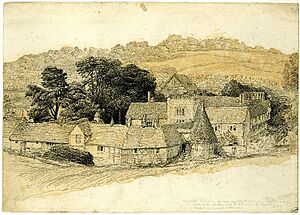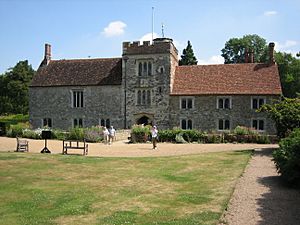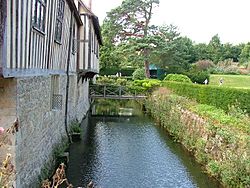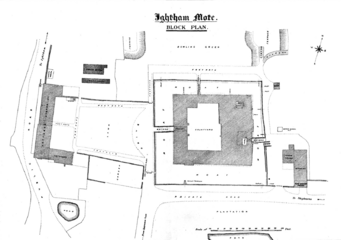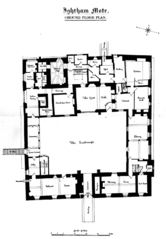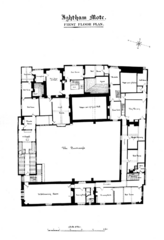Ightham Mote facts for kids
Quick facts for kids Ightham Mote |
|
|---|---|
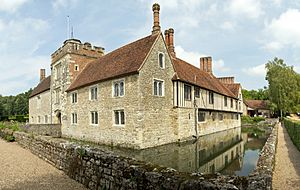 |
|
| Type | House |
| Location | Ightham, Kent |
| Built | Medieval |
| Architectural style(s) | Vernacular |
| Governing body | National Trust |
|
Listed Building – Grade I
|
|
| Official name: Ightham Mote | |
| Designated | 1 August 1952 |
| Reference no. | 1362410 |
| Lua error in Module:Location_map at line 420: attempt to index field 'wikibase' (a nil value). | |
Ightham Mote (pronounced EYE-təm MOHT) is a very old house in Kent, England. It's a medieval manor house surrounded by a moat (a deep, wide ditch filled with water). Experts say it's "the most complete small medieval manor house" in the area.
Today, Ightham Mote and its beautiful gardens are looked after by the National Trust. This means they are open for everyone to visit and explore. The house is a special Grade I listed building. Parts of it are also a Scheduled Ancient Monument, which means they are protected by law because they are so important.
Contents
A Look Back in Time: The History of Ightham Mote
Early Days: 1300s to 1500s
The house was first built around 1340 to 1360. One of the first known owners was Sir Thomas Cawne. He was a knight who fought in France. He bought the Mote in the 1360s. After his family, the house passed to the Haute family in 1399. Later, in 1521, a courtier named Sir Richard Clement bought it. Then, in 1591, Sir William Selby became the owner.
The Selby Family: 1500s to Late 1800s
The Selby family owned Ightham Mote for almost 300 years! One famous Selby, also named Sir William, gave the keys of Berwick-upon-Tweed to King James I. This happened when James was traveling south to become king.
Later, a part of the house was even changed into an oast house. This is a special building used to dry hops for making beer. In the late 1800s, the house was rented by an American railway boss, William Jackson Palmer. For three years, Ightham Mote became a place where famous artists and writers would visit. People like John Singer Sargent and Henry James came to stay.
Saving the Mote: Late 1800s to Today
In 1889, the house was put up for sale. It was bought by Thomas Colyer-Fergusson. He and his wife had six children who grew up there. He did a lot of important repair work. This helped save the house after many years of not being looked after. In the early 1900s, Ightham Mote was opened to the public one afternoon a week.
During World War I, Sir Thomas's son, Riversdale, died in battle. He was only 21. His bravery earned him a special medal called the Victoria Cross. Another son, Max, died in World War II.
After Sir Thomas died in 1951, the house needed a lot of expensive repairs. His grandson, James, had to sell it. Some people even thought about tearing the house down! But three local men bought it for £5,500. They hoped to save it for the future.
In 1953, an American man named Charles Henry Robinson bought Ightham Mote. He loved the house from earlier visits. He made many urgent repairs and filled the house with old English furniture. In 1965, he decided to give Ightham Mote and everything inside it to the National Trust. He passed away in 1985, and the National Trust took over.
From 1989 to 2004, the National Trust worked on a huge project. They carefully took parts of the building apart to fix them. They learned a lot about how the house was built. This work saved Ightham Mote from damage caused by age and insects.
The Look of Ightham Mote: Architecture and Design
Ightham Mote is special because it still has most of its original features. Not many changes were made to the main building over the years. It truly shows how a medieval manor house would have looked. The house is built from "Kentish ragstone" (a type of local stone) and red brick.
The house has more than 70 rooms! All of them are built around a central courtyard. The entire house is surrounded by a square moat, which you cross using three bridges. The oldest parts of the house are from the early 1300s. This includes the great hall, the chapel, and the crypt. The courtyard was completely enclosed over time. A tall, battlemented tower was added in the 1400s.
You can find some very unique features here. There's a "porter's squint," which is a narrow slit in the wall. This allowed the gatekeeper to check who was at the door before opening it. There's also an open area with a gallery above it. This connects the main rooms to the gatehouse. The house even has two chapels. The "New Chapel" from around 1520 has a beautiful curved ceiling decorated with Tudor roses.
Ightham Mote in Books
A lot of the story in Anya Seton's novel Green Darkness happens at Ightham Mote. The author was inspired to write the book after visiting the house in 1968. Charles Henry Robinson, who owned the house at the time, even let her use his library for her research!


